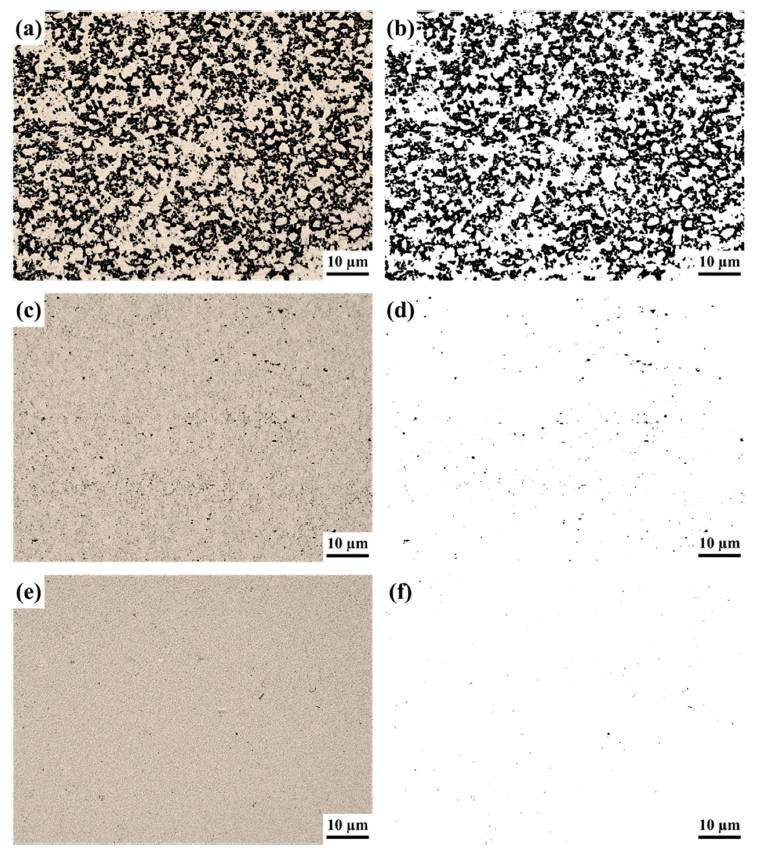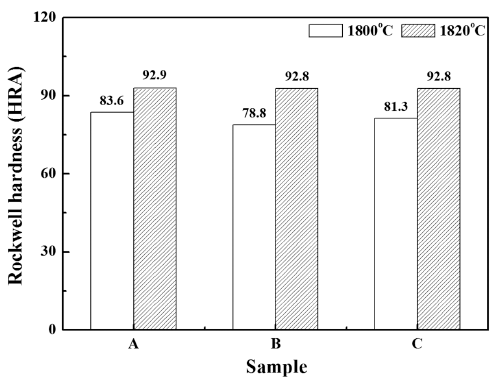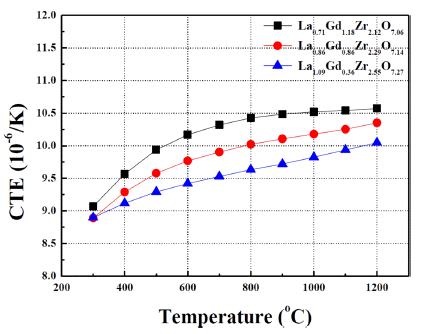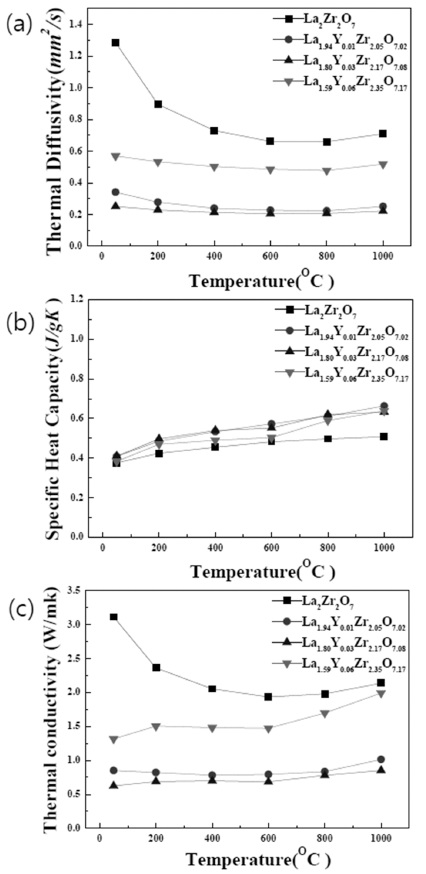Search
- Page Path
- HOME > Search
- [Korean]
- Phase Formation and Mechanical Property of YSZ‒30 vol.% WC Composite Ceramics Fabricated by Hot Pressing
- Jin-Kwon Kim, Jae-Hyeong Choi, Nahm Sahn, Sung-Soo Ryu, Seongwon Kim
- J Powder Mater. 2023;30(5):409-414. Published online October 1, 2023
- DOI: https://doi.org/10.4150/KPMI.2023.30.5.409

- 316 View
- 3 Download
-
 Abstract
Abstract
 PDF
PDF YSZ (Y2O3-stabilized zirconia)-based ceramics have excellent mechanical properties, such as high strength and wear resistance. In the application, YSZ is utilized in the bead mill, a fine-grinding process. YSZ-based parts, such as the rotor and pin, can be easily damaged by continuous application with high rpm in the bead mill process. In that case, adding WC particles improves the tribological and mechanical properties. YSZ-30 vol.% WC composite ceramics are manufactured via hot pressing under different pressures (10/30/60 MPa). The hot-pressed composite ceramics measure the physical properties, such as porosity and bulk density values. In addition, the phase formation of these composite ceramics is analyzed and discussed with those of physical properties. For the increased applied pressure of hot pressing, the tetragonality of YSZ and the crystallinity of WC are enhanced. The mechanical properties indicate an improved tendency with the increase in the applied pressure of hot pressing.
- [Korean]
- Phase Formation and Physical Properties of SiAlON Ceramics Fabricated by Gas-Pressure Reactive Sintering
- Soyul Lee, Jae-Hyeong Choi, Yoonsoo Han, Sung-Min Lee, Seongwon Kim
- J Korean Powder Metall Inst. 2017;24(6):431-436. Published online December 1, 2017
- DOI: https://doi.org/10.4150/KPMI.2017.24.6.431

- 562 View
- 5 Download
-
 Abstract
Abstract
 PDF
PDF SiAlON-based ceramics are some of the most typical oxynitride ceramic materials, which can be used as cutting tools for heat-resistant super-alloys (HRSA). SiAlON can be fabricated by using gas-pressure reactive sintering from the raw materials, nitrides and oxides such as Si3N4, AlN, Al2O3, and Yb2O3. In this study, we fabricate Ybm/3Si12-(m+n)Alm+nOnN16-n (m=0.3, n=1.9, 2.3, 2.7) ceramics by using gas-pressure sintering at different sintering temperatures. Then, the densification behavior, phase formation, microstructure, and hardness of the sintered specimens are characterized. We obtain a fully densified specimen with β- SiAlON after gas-pressure sintering at 1820°C for 90 min. under 10 atm N2 pressure. These SiAlON ceramic materials exhibited hardness values of ~92.9 HRA. The potential of these SiAlON ceramics for cutting tool application is also discussed.
- [Korean]
- Phase Formation and Thermo-physical Properties of Lanthanum/Gadolinium Zirconate with Reduced Rare-earth Contents for Thermal Barrier Coatings
- Sujin Lee, Chang-Sup Kwon, Sung-Min Lee, Yoon-Suk Oh, Hyung-Tae Kim, Sahn Nahm, Seongwon Kim
- J Korean Powder Metall Inst. 2015;22(6):420-425. Published online December 1, 2015
- DOI: https://doi.org/10.4150/KPMI.2015.22.6.420

- 638 View
- 2 Download
- 3 Citations
-
 Abstract
Abstract
 PDF
PDF Rare-earth zirconates, such as lanthanum zirconates and gadolinium zirconates, have been intensively investigated due to their excellent properties of low thermal conductivity as well as chemical stability at high temperature, which can make these materials ones of the most promising candidates for next-generation thermal barrier coating applications. In this study, three compositions, lanthanum/gadolinium zirconates with reduced rare-earth contents from stoichiometric RE2Zr2O7 compositions, are fabricated via solid state reaction as well as sintering at 1600°C for 4 hrs. The phase formation, microstructure, and thermo-physical properties of three oxide ceramics are examined. In particular, each oxide ceramics exhibits composite structures between pyrochlore and fluorite phases. The potential of lanthanum/ gadolinium zirconate ceramics for TBC applications is also discussed.
-
Citations
Citations to this article as recorded by- Rare earth zirconate nanostructures: Recent development on preparation and photocatalytic applications
Sahar Zinatloo-Ajabshir, Masoud Salavati-Niasari, Azam Sobhani, Zahra Zinatloo-Ajabshir
Journal of Alloys and Compounds.2018; 767: 1164. CrossRef - A novel Co-ions complexation method to synthesize pyrochlore La 2 Zr 2 O 7
Chunhui Xu, Hongyun Jin, Qifeng Zhang, Can Huang, Daifeng Zou, Fujian He, Shuen Hou
Journal of the European Ceramic Society.2017; 37(8): 2871. CrossRef - Fabrication and Characteristics of Thermal Barrier Coatings in the La2O3-Gd2O3-ZrO2System by Using Suspension Plasma Spray with Different Suspension Preparations
Soyul Lee, Sung-Min Lee, Yoon-Suk Oh, Hyung-Tae Kim, Sahn Nahm, Seongwon Kim
Journal of the Korean institute of surface engineering.2016; 49(6): 595. CrossRef
- Rare earth zirconate nanostructures: Recent development on preparation and photocatalytic applications
- [Korean]
- Fabrication and Characterization of Ceramics and Thermal Barrier Coatings of Lanthanum Zirconate with Reduced Rare-earth Contents in the La2O3-ZrO2 System
- Chang-Sup Kwon, Sujin Lee, Sung-Min Lee, Yoon-Suk Oh, Hyung-Tae Kim, Byung-Koog Jang, Seongwon Kim
- J Korean Powder Metall Inst. 2015;22(6):413-419. Published online December 1, 2015
- DOI: https://doi.org/10.4150/KPMI.2015.22.6.413

- 344 View
- 2 Download
- 1 Citations
-
 Abstract
Abstract
 PDF
PDF Lanthanum zirconate, La2Zr2O7, is one of the most promising candidates for next-generation thermal barrier coating (TBC) applications in high efficient gas turbines due to its low thermal conductivity and chemical stability at high temperature. In this study, bulk specimens and thermal barrier coatings are fabricated via a variety of sintering processes as well as suspension plasma spray in lanthanum zirconates with reduced rare-earth contents. The phase formation, microstructure, and thermo-physical properties of these oxide ceramics and coatings are examined. In particular, lanthanum zirconates with reduced rare-earth contents in a La2Zr2O7-4YSZ composite system exhibit a single phase of fluorite or pyrochlore after fabricated by suspension plasma spray or spark plasma sintering. The potential of lanthanum zirconate ceramics for TBC applications is also discussed.
-
Citations
Citations to this article as recorded by- Phase Formation and Thermo-physical Properties of Lanthanum/Gadolinium Zirconate with Reduced Rare-earth Contents for Thermal Barrier Coatings
Sujin Lee, Chang-Sup Kwon, Sung-Min Lee, Yoon-Suk Oh, Hyung-Tae Kim, Sahn Nahm, Seongwon Kim
Journal of Korean Powder Metallurgy Institute.2015; 22(6): 420. CrossRef
- Phase Formation and Thermo-physical Properties of Lanthanum/Gadolinium Zirconate with Reduced Rare-earth Contents for Thermal Barrier Coatings
TOP
 kpmi
kpmi


 First
First Prev
Prev


